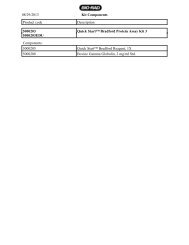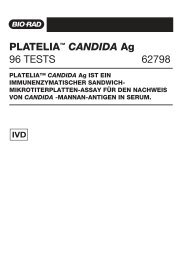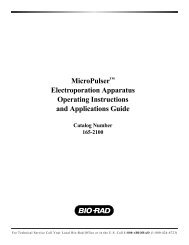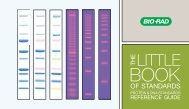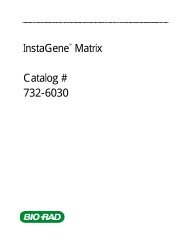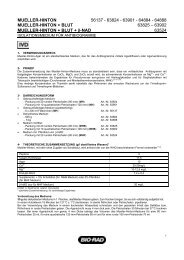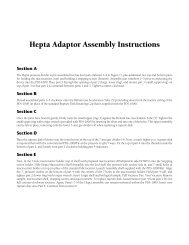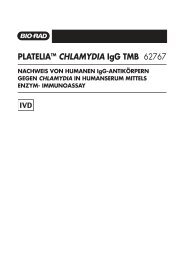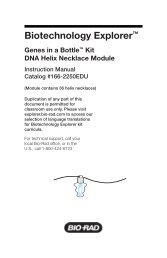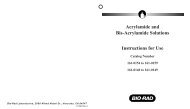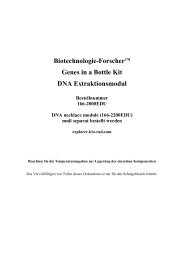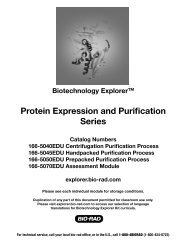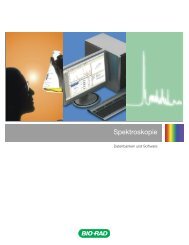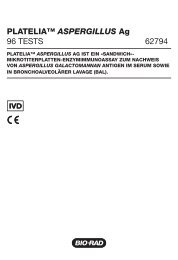Fast Blast DNA Stain (500x), Biotechnology Explorer - Bio-Rad
Fast Blast DNA Stain (500x), Biotechnology Explorer - Bio-Rad
Fast Blast DNA Stain (500x), Biotechnology Explorer - Bio-Rad
Create successful ePaper yourself
Turn your PDF publications into a flip-book with our unique Google optimized e-Paper software.
<strong>Fast</strong> <strong>Blast</strong> <strong>DNA</strong> <strong>Stain</strong> (<strong>500x</strong>)<br />
100 ml<br />
Instruction Manual<br />
Catalog #166-0420EDU<br />
Store at room temperature. Stable for 1 year from purchase.
Table of Contents<br />
Section 1 Introduction ..................................................................1<br />
Section 2 Features of <strong>Fast</strong> <strong>Blast</strong> <strong>DNA</strong> <strong>Stain</strong>..................................3<br />
Section 3 Directions for Using <strong>Fast</strong> <strong>Blast</strong> <strong>DNA</strong> <strong>Stain</strong> ....................5<br />
Protocol 1: Quick <strong>Stain</strong>ing..........................................................5<br />
Protocol 2: Overnight <strong>Stain</strong>ing....................................................9<br />
Section 4 Ordering Information...................................................11
Section 1<br />
Introduction<br />
<strong>Fast</strong> <strong>Blast</strong> <strong>DNA</strong> stain is a convenient, safe, and nontoxic alternative to ethidium<br />
bromide for the detection of <strong>DNA</strong> in agarose gels following electrophoresis.<br />
<strong>Fast</strong> <strong>Blast</strong> contains a cationic compound that is in the thiazin family of dyes. The<br />
positively charged dye molecules are attracted to and bind to the negatively<br />
charged phosphate groups on <strong>DNA</strong> molecules. The proprietary dye formula<br />
stains <strong>DNA</strong> deep blue in agarose gels and provides vivid, consistent results. <strong>Fast</strong><br />
<strong>Blast</strong> <strong>DNA</strong> stain is provided as a <strong>500x</strong> concentrate that must be diluted prior to<br />
use. The stain can be used as a quick stain when diluted to 100x or as an<br />
overnight stain when diluted to 1x, making it ideal for classroom use. <strong>Fast</strong> <strong>Blast</strong><br />
can also be added to an agarose gel and electrophoresis buffer to stain <strong>DNA</strong><br />
while the gel is running (visit explorer.bio-rad.com for more detailed<br />
information).<br />
Agarose gels stained with <strong>Fast</strong> <strong>Blast</strong> <strong>DNA</strong> stain can be air-dried on our unique gel<br />
support film for agarose (catalog #170-2984EDU). Once dried, stained gels can<br />
1
e taped into a laboratory notebook as a permanent record of the experiment.<br />
<strong>Fast</strong> <strong>Blast</strong> <strong>DNA</strong> stain is a versatile stain that can also be used as a nuclear stain<br />
for cheek cells or simply electrophoresed on agarose gels to teach students<br />
about basic principles of electrophoresis (visit explorer.bio-rad.com for more<br />
detailed information).<br />
2
Section 2<br />
Features of <strong>Fast</strong> <strong>Blast</strong> <strong>DNA</strong> <strong>Stain</strong><br />
Safety<br />
<strong>Fast</strong> <strong>Blast</strong> <strong>DNA</strong> stain is nontoxic and noncarcinogenic, and the waste generated<br />
is not considered hazardous. Although the stain is nontoxic, latex or vinyl gloves<br />
should be worn while handling the stain or stained gels to keep hands from<br />
becoming stained blue. Lab coats or other protective clothing should be worn to<br />
avoid staining clothes. Dispose of the staining solutions according to protocols at<br />
your facility.<br />
Use either 10% bleach solution or a 70% alcohol solution to remove <strong>Fast</strong> <strong>Blast</strong><br />
from most surfaces. Verify that these solutions do not harm the surface prior to use.<br />
Cost Effectiveness<br />
<strong>Fast</strong> <strong>Blast</strong> <strong>DNA</strong> stain provides an inexpensive method of documenting the results<br />
of <strong>DNA</strong> electrophoresis experiments. Gels stained with <strong>Fast</strong> <strong>Blast</strong> can simply be<br />
dried on gel support film for agarose and taped into a laboratory notebook,<br />
eliminating the need to purchase expensive gel documentation equipment. At the<br />
3
100x strength, <strong>Fast</strong> <strong>Blast</strong> can be reused for quick staining at least 7 times. The<br />
<strong>500x</strong> concentrate also makes up to 50 L of 1x solution for overnight staining,<br />
making it a more cost-effective product than many other comparable stains on<br />
the market.<br />
Timing<br />
Because <strong>Fast</strong> <strong>Blast</strong> is a nonfluorescent visible stain, the staining protocol takes<br />
longer than traditional fluorescent <strong>DNA</strong> stains such as ethidium bromide that give<br />
rapid results. <strong>Fast</strong> <strong>Blast</strong> can be used as a quick stain to visualize <strong>DNA</strong> within<br />
15 min, or can be diluted for overnight staining.<br />
Sensitivity<br />
The sensitivity of <strong>Fast</strong> <strong>Blast</strong> <strong>DNA</strong> stain is more than sufficient for most teaching<br />
lab applications. <strong>Fast</strong> <strong>Blast</strong> allows the visualization of as little as 50 ng of <strong>DNA</strong><br />
resolved in an agarose gel when used as either a quick stain or an overnight<br />
stain.<br />
4
Section 3<br />
Directions for Using <strong>Fast</strong> <strong>Blast</strong> <strong>DNA</strong> <strong>Stain</strong><br />
Below are two protocols for using <strong>Fast</strong> <strong>Blast</strong> <strong>DNA</strong> stain in the classroom. Use<br />
protocol 1 for quick staining of gels to visualize <strong>DNA</strong> bands within 15 min, and<br />
protocol 2 for overnight staining. Visit explorer.bio-rad.com for additional<br />
protocols for using this stain as a nuclear stain for cheek cells or as an in-gel<br />
stain during electrophoresis.<br />
Protocol 1: Quick <strong>Stain</strong>ing of Agarose Gels in<br />
100x <strong>Fast</strong> <strong>Blast</strong> <strong>DNA</strong> <strong>Stain</strong><br />
This protocol allows quick visualization of <strong>DNA</strong> bands in agarose gels within<br />
15 min. For quick staining, <strong>Fast</strong> <strong>Blast</strong> <strong>DNA</strong> stain (<strong>500x</strong>) should be diluted to a<br />
100x concentration. We recommend using 120 ml of 100x <strong>Fast</strong> <strong>Blast</strong> to stain two<br />
7 x 7 cm or 7 x 10 cm agarose gels in individual staining trays provided in<br />
<strong>Bio</strong>-<strong>Rad</strong>’s education kits. If alternative staining trays are used, add a sufficient<br />
volume of staining solution to completely submerge the gels.<br />
5
Following electrophoresis, agarose gels must be removed from their gel trays<br />
before being placed in the staining solution. This is easily accomplished by<br />
holding the base of the gel tray in one hand and gently pushing out the gel with<br />
the thumb of the other hand. Because the gel is fragile, special attention must be<br />
given when handling it. We highly recommend using a large spatula or other<br />
supportive surface to transfer the gel from one container to another. Destaining<br />
requires the use of at least one large-volume container, capable of holding at<br />
least 500 ml, at each student workstation. Each student team may utilize<br />
separate washing containers for each wash step, or simply use a single container<br />
that is emptied after each wash and refilled for the next wash.<br />
1. Prepare 100x <strong>Fast</strong> <strong>Blast</strong> <strong>DNA</strong> stain<br />
Dilute 100 ml of <strong>500x</strong> <strong>Fast</strong> <strong>Blast</strong> <strong>DNA</strong> stain with 400 ml of deionized water in an<br />
appropriately sized flask and mix. Cover the flask and store at room temperature<br />
until ready to use.<br />
2. <strong>Stain</strong> gel (2–3 min)<br />
Pour 100x stain into a gel staining tray. Remove the gel from the gel tray and<br />
carefully slide it into the staining tray containing the stain. If necessary, add more<br />
100x stain to completely submerge the gel. <strong>Stain</strong> the gel for 2–3 min, but not for<br />
6
more than 3 min. Using a funnel, pour the 100x stain into a storage bottle and<br />
save it for future use. The stain can be reused at least 7 times.<br />
3. Rinse gel (10 sec)<br />
Transfer the gel into a large container containing 500–700 ml of clean, warm<br />
(40–55°C) tap water. Gently shake the gel in the water for ~10 sec to rinse.<br />
4. Wash gel (5 min)<br />
Transfer the gel into a large container with 500–700 ml of clean, warm tap water.<br />
Gently rock or shake the gel on a rocking platform (catalog #166-0609EDU) for<br />
5 min. If no rocking platform is available, move the gel gently in the water once<br />
every minute.<br />
5. Wash gel (5 min)<br />
Perform a second wash as in step 4.<br />
6. Analyze results<br />
Examine the stained gel for expected <strong>DNA</strong> bands. The bands may appear fuzzy<br />
immediately after the second wash, but will begin to develop into sharper bands<br />
within 5–15 min after the second wash. This is due to <strong>Fast</strong> <strong>Blast</strong> dye molecules<br />
migrating into the gel and binding more tightly to the <strong>DNA</strong> molecules.<br />
7
To obtain maximum contrast, additional washes in warm water may be<br />
necessary. Destain to the desired level, but do not wash the gel in water<br />
overnight. If you cannot complete the destaining in the allocated time, you may<br />
transfer the gel to 1x <strong>Fast</strong> <strong>Blast</strong> stain for overnight staining. See Protocol 2.<br />
7. Dry gel<br />
Place the gel onto the hydrophilic side of a sheet of gel support film. Let the gel<br />
dry in a well-ventilated area, but avoid exposure of the stained gel to direct light.<br />
The stained gel will fade if left exposed to direct light for an extended period of<br />
time. (The <strong>DNA</strong> bands will reappear if the gel is stored in the dark for 2–3 weeks<br />
after fading.)<br />
8
Protocol 2: Overnight <strong>Stain</strong>ing of Agarose Gels in<br />
1x <strong>Fast</strong> <strong>Blast</strong> <strong>DNA</strong> <strong>Stain</strong><br />
For overnight staining, <strong>Fast</strong> <strong>Blast</strong> <strong>DNA</strong> stain (<strong>500x</strong>) should be diluted to a<br />
1x concentration. We recommend using 120 ml of 1x <strong>Fast</strong> <strong>Blast</strong> to stain two<br />
7 x 7 cm or 7 x 10 cm agarose gels in individual staining trays provided in<br />
<strong>Bio</strong>-<strong>Rad</strong>’s education kits. If alternative staining trays are used, add a sufficient<br />
volume of staining solution to completely submerge the gels.<br />
Following <strong>DNA</strong> electrophoresis, agarose gels must be removed from their gel<br />
trays before being placed in the staining solution. This is easily accomplished by<br />
holding the base of the gel tray in one hand and gently pushing out the gel with<br />
the thumb of the other hand. Because the gel is fragile, special attention must<br />
be given when handling it.<br />
1. Prepare 1x <strong>Fast</strong> <strong>Blast</strong> <strong>DNA</strong> stain<br />
Add 1 ml of <strong>500x</strong> <strong>Fast</strong> <strong>Blast</strong> to 499 ml of deionized water in an appropriately<br />
sized flask and mix. If you already have a 100x <strong>Fast</strong> <strong>Blast</strong> solution, add 5 ml of<br />
100x <strong>Fast</strong> <strong>Blast</strong> to 495 ml of deionized water and mix. Cover the flask and store<br />
at room temperature.<br />
9
2. <strong>Stain</strong> gel (overnight)<br />
Pour 1x stain into a gel staining tray. Remove the gel from the gel tray and<br />
carefully slide it into the staining tray containing the stain. If necessary, add more<br />
1x staining solution to completely submerge the gel. Place the staining tray on a<br />
rocking platform and agitate overnight. If no rocking platform is available, agitate<br />
the gel staining tray a few times during the staining period. You should begin to<br />
see <strong>DNA</strong> bands after 2 hr, but at least 8 hr of staining is recommended for<br />
complete visibility of stained bands.<br />
3. Analyze results<br />
No destaining is required after staining with 1x <strong>Fast</strong> <strong>Blast</strong>. The gels can be<br />
analyzed immediately after staining.<br />
4. Dry gel<br />
Place the gel onto the hydrophilic side of a sheet of gel support film. Let the gel<br />
dry in a well-ventilated area, but avoid exposure of the stained gel to direct light.<br />
The stained gel will fade if left exposed to direct light for an extended period of<br />
time. (The <strong>DNA</strong> bands will reappear if the gel is stored in the dark for 2–3 weeks<br />
after fading.)<br />
10
Section 4<br />
Ordering Information<br />
Catalog # Description<br />
161-3100EDU Molecular <strong>Bio</strong>logy Agarose, 25 g<br />
166-0401EDU <strong>DNA</strong> Sample Loading Buffer, 5x, 1 ml<br />
170-2984EDU Gel Support Film, for drying agarose gels, 50 sheets<br />
161-0733EDU TBE Buffer, 10x, 1 L<br />
161-0743EDU TAE Buffer, 50x, 1 L<br />
170-4467EDU Mini-Sub ® Cell GT Cell, with 7 x 10 cm tray and gel caster, 8-well<br />
and 15-well combs<br />
165-5050EDU PowerPac TM<br />
Basic Power Supply<br />
166-0609EDU UltraRocker TM<br />
Rocking Platform<br />
170-8356EDU EZ Load TM<br />
Precision Molecular Mass Ruler<br />
161-3057EDU ReadyAgarose TM<br />
Gel, 1%, TAE, 2 x 8-well<br />
166-0007EDU <strong>DNA</strong> Fingerprinting Kit, supports 8 workstations or 32 students<br />
166-2100EDU PV92 PCR/Informatics Kit, supports 8 workstations or 32 students<br />
166-0001EDU Analysis of Precut Lambda <strong>DNA</strong> Kit, supports 8 workstations or 32 students<br />
166-0002EDU Restriction Digestion and Analysis of Lambda <strong>DNA</strong> Kit, supports 8 workstations<br />
or 32 students<br />
11
<strong>Bio</strong>-<strong>Rad</strong> Laboratories, Inc.<br />
2000 Alfred Nobel Dr., Hercules, CA 94547 USA<br />
510-741-1000 4110153 Rev A



